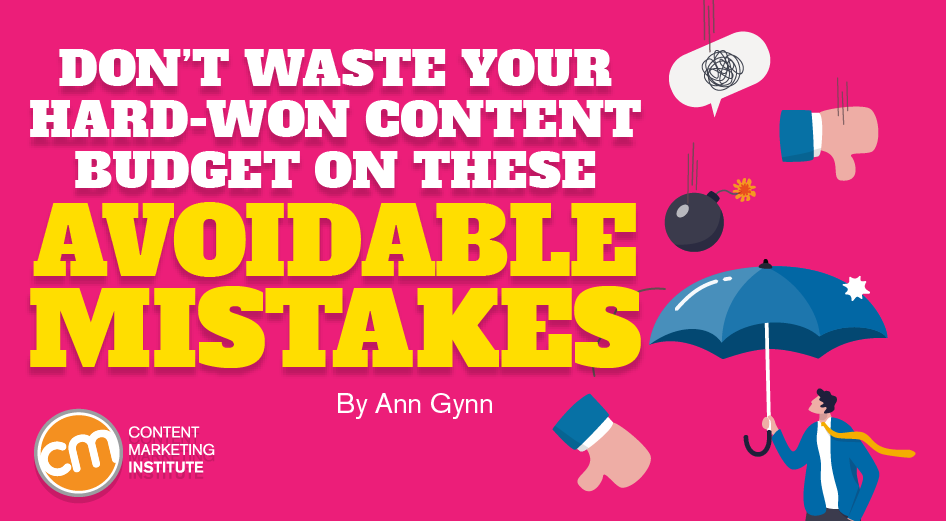MARKETING
Don’t Waste Your Hard-Won Content Budget on These Avoidable Mistakes

More money shouldn’t mean more money wasted.
Over 60% of marketers in CMI’s annual research say they expected bigger content marketing budgets in 2022 as compared to 2021. To spend that increase wisely – or make better use of your existing (or reduced) budget – look to trim costly errors and oversights out of your approach.
The presenters at Content Marketing World 2022 share some of the biggest content marketing budget mistakes they see. While they don’t all agree about tech investments, their opinions are well-aligned regarding audience-related costs. They also had plenty to say about old-school techniques, grounding elements, and more.
How many of these mistakes will you rectify? (And how many have you already avoided?)
Assuming rather than asking
The best way to blow your content budget is to write the wrong rebuttal – I Didn’t Ask, They Didn’t Answer – to Marcus Sheridan’s epic tome They Ask, You Answer. Yep, that’s right. Assuming you know your audience and spending loads of cash without getting to know them for real – in the pub, coffee shop, or even on Zoom – that’s where you go wrong.
You should talk to them, not just at the beginning of your process but throughout. Always ask: Does this make sense? Does this still make sense? Change things up regularly based on the responses you get. We get so caught up in what we think they want and forget to take the time to find out what they want. – Jon Burkhart, founder, TBC Global Limited
Creating content your audience doesn’t care about
Spending time and resources on creating, publishing, and promoting content that won’t meet your target audience’s needs and expectations is a waste. A significant part of your budget should be spent researching your audience, understanding their reason for interacting with your content, receiving feedback, or simply talking to them. – Igor Bielobradek, digital marketing senior manager, Deloitte
Dismissing the experience
Every part of our investment will be a waste – from the data we collect to the content we create – unless we focus on the content experience. Your buyer expects to find the content relevant to them and not have to sift through content meant for other audiences. A focus on the experience is everything, from the environment in which your content lives to the structure that allows for personalization and context. – Randy Frisch, chief evangelist, Uberflip
Investing based on internal leaders’ opinions
Spending time and money on product content based on the whims and egos of sales, product teams, and executives. Map content to the buyer journey, and you will find that the biggest gap is always in education, context, and use cases. – Michael Brenner, CEO, Marketing Insider Group
Not doing your research
Any content marketing dollars spent without a fundamental, research- and data-driven understanding of the buyer journey and buyer personas are wasted. – Mark Emond, president, Demand Spring
Expecting success without knowing the audience
The biggest waste of money is making any content without a clear understanding of your target audience. You need to know their story – their emotions, pains, fears, hopes, and goals – and what your obstacles are to reaching them. – Tim Schmoyer, founder/CEO, Video Creators
Creating for no one
The biggest waste of a content marketing budget is creating content that provides no value to the audience. Corporations and brands churn out massive amounts of content every single day that no one asks for, no one wants, and no one cares about. Here’s the simplest way to check whether your content was a waste: Would you pay out of your pocket, even a dollar, for your company’s most recent content campaign? If the answer is no, then your content was a waste. – Christopher Penn, chief data scientist, TrustInsights.ai
Failing to connect the what to the who
The biggest waste is spending time and money creating the wrong content for the right audience. When you do not take the time to truly identify who you are trying to engage and what engages them, it’s like throwing spaghetti with random content types. You do a disservice to the brand and the audience. It’s such a waste of time creating white papers for audiences that simply want to watch 15-second video clips. – Michael Weiss, vice president of consulting services and solutions, Creative Circle
The biggest waste is spending time and money creating the wrong #content for the right audience, says @mikepweiss via @AnnGynn @CMIContent. #CMWorld Click To Tweet
Promoting content where your audience isn’t
There’s no use in promoting content via certain channels if that’s not where your target audiences are spending time. – Michelle Garrett, consultant, Garrett Public Relations
Expecting tech to solve process problems
Throwing tools and technology at a process problem is a budget mistake. You may think you’re doing something about your ways of working when you buy a shiny new piece of software. But if you don’t address the real underlying issues, there’s not much a tool can do. Visualize your work first (I love a good Kanban board for this). It’s likely the bottleneck isn’t where you thought. Buying a tool to fix the wrong problem is a huge waste of a much-needed budget. – Andrea Fryrear, CEO and co-founder, AgileSherpas
Going all in with automation before you’re ready
Overpriced automation platforms. Don’t buy a $1,000-a-month tool unless you’re ready to get the full value from it. That usually means you have strong, gate-worthy content assets, an engaged list of subscribers, a documented content strategy, and a website designed specifically to convert visitors. – Andy Crestodina, co-founder and chief marketing officer, Orbit Media Studios
Seeing tech as the elixir
Purchasing software that isn’t properly adopted and integrated. Too often, we think that technology will magically solve our problems without putting in the time and effort to get leadership buy-in, proper implementation, and adequate training. – Brian Piper, director of content strategy and assessment, University of Rochester
Investing in tools more than writers
Spending too much money on tools and not enough on quality writers, in-house or otherwise. All too often, brands rely on tools to fix and make up for poor-quality content. Don’t get me wrong – I’m a big fan of editing and creation tools like Frase.io, Grammarly, and Semrush. They can provide the SEO and grammatical edge to compete with the best of the best, but they can’t make a dead canary sing. Invest in your wordy birds first. Let the tools sweeten their song, not replace it (or autotune it). – Haley Collins, director of operations and content, GPO
Invest in your wordy birds. Let tech tools sweeten their song, not replace or autotune it, says Haley Collins via @AnnGynn @CMIContent #CMWorld Click To Tweet
Making humans do all the heavy lifting
It’s a mistake to rely on 100% human-powered content strategy and production. Dozens of AI-powered technologies can reduce the costs of planning and creating content. – Paul Roetzer, CEO, Marketing AI Institute
Underusing automation tools
Marketing automation is worth every penny if you can optimize it and measure the ROI. Continuously audit your tools to make sure you’re getting the most for your budget and cut anything that isn’t contributing to your bottom line. – Ahava Leibtag, founder and president, Aha Media Group
Working with too many vendors
A lot of resource waste (time and money) happens when marketers use too many vendors or technologies. Often, you can save your budget by using fewer trusted vendors and bundling more of their services into one contract. Marketers should ask vendors what services and products they offer to see if they can condense their vendor list. – Brittany Graff, senior director of marketing, Painting with a Twist
Adding tools that add time
We use a tool (I won’t name it) that helps us create more SEO-worthy content. I would usually spend a few hours on a blog post. Now, I spend four to six hours getting all the keywords, paragraphs, titles, and images to align with this tool’s scoring system. My time is worth more than that.
I get the ROI in the long run, but since this function is not naturally aligned with my skill sets, I feel like it’s a waste of my time, which considering how much I get paid, is a ding on our budget too. Does anyone else feel like you’re trying to make your content fit into an SEO mold? – Viveka von Rosen, chief visibility officer, Vengreso
Deprioritizing planning and analysis
All too often, organizations deprioritize content planning and evaluation in favor of constantly cranking out new content. This leads to random acts of content – content created without considering the relevant content needed – and/or publishing without a promotion strategy.
Stop setting goals around creating a certain volume of content. Instead, aim to have the right mix of content that resonates with your target audiences at key stages of their buyer’s journey.
To achieve this, place equal weight on content strategy, development, and evaluation. A content lifecycle plan will help keep site content fresh and increase the likelihood that existing content assets can be reworked for future marketing campaigns.
You can also create a content scorecard and frequently evaluate your metrics to inform data-driven decisions, ensuring each piece of content created has a purpose and meets your goals. – Wendy Covey, CEO and co-founder, TREW Marketing
Sharing opinions instead of data
A big content waste is sharing low-value opinions instead of high-value data. Buyers don’t care about your opinions and are increasingly suspicious of them. They want independent data that grows their knowledge and business. – Justin Ethington, partner, TrendCandy
Continually creating all-new content
The biggest waste of a content marketing budget just might be in the creation of new content. Yes, you heard me. Content marketing is based on content creation, and this will often take up a great percentage of a content marketing budget. But do you always need to create new content?
Smart organizations know that at a point, they have all the core content they need in their “library.” They shift by leveraging content as their intellectual property and focusing on repurposing and republishing it. This ensures a greater ROI and frees-up resources for those things that you’ve been putting off, like those short-form videos. – Neal Schaffer, president, PDCA Social
The biggest waste of a #ContentMarketing budget just might be in the creation of new content, says @NealSchaffer via @AnnGynn @CMIContent. #CMWorld Click To Tweet
Only using content once
The biggest waste of a content marketing budget is when content isn’t repurposed or distributed to its full potential. If you spend hours, days, or weeks creating a fantastic, high-value piece of content, you need to squeeze every last drop of value from it.
Repurposing your content is the No. 1 way to make your content marketing budget go further. Consider how to promote that content over time and repurpose it to produce more high-value pieces. It will help you get the maximum return, connect with a broader audience, and eliminate wasted time, effort, and budget. – Amy Woods, founder and CEO, Content 10x
Failing to iterate
The two biggest mistakes I often see are: 1. Not thinking through the strategy and pouring budget/mindshare/effort into a bucket that might not yield the results you expect. 2. The failure to iterate and adapt once a strategy is in place.
It’s essential to monitor, analyze, and – pardon the jargon – pivot, when necessary. This doesn’t mean abandoning ship if you’re not hitting a specific benchmark or KPI immediately. Rather, always operate as if your hypothesis could be (and likely is) wrong. Often, a strategy takes longer than a few months to drive results, but it’s our job as marketers to infer insights and signals from our audiences and adjust accordingly.
TL;DR: Assess, evaluate, and optimize. – Michael Bordieri, senior content solutions consultant, LinkedIn
Duplicating instead of localizing content
Far too often, we see brands using duplicative content on their websites – particularly on their local pages. Google loves unique, localized content, so it can be a waste of time and budget to invest in tools that duplicate content for multiple business units and locations. Unique, localized content at scale is a smarter investment, especially for large brands with hundreds (or even thousands) of locations. – Jane Marie Barnes, account manager, GPO
Thinking you can buy success
Betting on paid before proving organic. You can’t just throw money at content – that’s like winking in the dark. You have to roll up your sweatshirt sleeves and do the (sometimes) painstaking work of writing social media posts, blogs, or newsletters, creating low-rent videos, and conducting your own webinars or podcasts – no matter how unpolished they may be.
You don’t have to be perfect. But you do have to have firsthand knowledge. No way of learning is more valuable than experiencing the pain yourself because the hard way is the way. It can mean the difference between creating legacy content that will drive exponential traffic your way for years and creating evaporative content that offers only a one-time punch. – Kate Bradley Chernis, co-founder and CEO, Lately
Using stock-like assets
In general, there is a lot of waste in some of the old-school “marketing assets,” like those created through professional photoshoots. Today’s consumer is savvy and cynical about stock-like photos and videos. Find more authentic ways to be professional and creative. – Jacquie Chakirelis, chief digital strategy officer, Quest Digital/ Great Lakes Publishing
Stocking up
It is hard to get away from stock photography, but do you want to use the same images in your marketing that your competitors may? It is worth hiring a professional photographer to create visuals unique to your company or brand. They can take enough shots, so you don’t have to use the same images repeatedly. You also can get photos in different settings and angles and with different models. – Andi Robinson, global digital content marketing, Corteva Agriscience
Ignoring the power of predictions
Creating content that has no opportunity to be successful is the largest waste of budget. Failing to implement predictive technologies to get high content success rates, test plans, and reporting confidence is the combined cause of the waste. – Jeff Coyle, co-founder, CSO, MarketMuse
Rushing into the metaverse
Right now, it’s spending money on design and development of metaverse experiences. I just don’t see the payoff beyond the PR that comes with doing something neat there. – Jason Falls, senior influence strategist, Cornett
Piecemeal outsourcing
Many marketers will hand off parts of projects for outside agencies to complete. When we do this, we often end up reducing our ROI due to the huge knowledge gaps. Instead, we can increase ROI by having external creators focus on projects where they have a unique, “outsider” viewpoint – for example, using an agency that focuses on influencer marketing or audience research. You could also maximize agency ROI by including them, as an extension of your team, on large-scale projects. Then, have your internal team help round out the rest. For example, the agency can create a larger, gated asset, and your internal team can craft the subject matter expert blogs and promotional materials. – Amy Higgins, senior director, content marketing, Twilio
Following trendy channels
A lot of companies start distributing content through certain channels simply because they are in vogue. That’s what happened with Facebook; that’s how it is today with YouTube and podcasts. There’s nothing wrong with these channels. They are useful – as long as you know how to get returns on that investment. – Cassio Politi, founder, Tracto Content Marketing
Calling it quits
Starting a program and stopping it in less than 17 months. – Joe Pulizzi, founder, The Tilt
Paying to promote free content
Using paid advertising to generate page views of an ungated asset is a waste. Why? It tells me you’re not taking advantage of tried-and-true organic methods first – optimizing for search engines, involving influencers in your content, or creating high-quality content in the first place. – Dennis Shiao, founder, Attention Retention
Creating content without revenue objectives
Creating content for content’s sake might be the most significant waste of a content marketing budget. Creating content can be an essential part of a modern marketing strategy. Still, without a clear understanding that our content must drive revenue (and must be measured with that in mind), it’s easy to check the content marketing box without clearly understanding how (or if) our content contributes to sales. – Andrew Davis, author and keynote speaker, Monumental Shift
Ignoring the business impact
The biggest waste of content marketing budget is when it’s spent on content that lacks a clear business goal or isn’t being measured. If you create content that can be measured and tied to business results – and build your strategy on the business’ real needs – your budget will be well spent. Even when an initiative fails, you’ll learn how to use your budget more wisely next time. That, in itself, is worth the waste. – Inbar Yagur, vice president of marketing, GrowthSpace
Failing to plan well
Poor planning. Only spend time and money on projects that have clear end goals. Who is this content going to reach? How will they find it? What will they do after engaging with the content? How will you know if the project was successful? Know your expected outcomes before you start a project. – Penny Gralewski, senior director, product and portfolio marketing, DataRobot
Operating without a strategy
The biggest waste of a content marketing budget is spending and creating without a foundational strategy. Don’t just create. Create intentionally.
Do you know the audience segments you’re trying to reach? Do you know their channel preferences and content consumption behaviors? Have you thought deeply about what your brand voice should be? Have you built the content pillars of your program – the topics you’ll cover from a unique perspective and how they’ll add value to your audiences?
These are just a few of the questions. If you don’t ask them, you set yourself up to create content nobody will read, view, hear, etc. If you build it, they won’t come unless you give them a reason to. – Chris Blose, founder, Chris Blose Content
Lacking a strong foundation
Creating content without a strategy can lead to waste. You need to outline what you’re going to say, who will care about it, where it should be delivered for maximum impact, and how it will be measured for success or improvement. Without assessing those factors, you are wasting valuable time and money. – Karen McFarlane, chief marketing officer, LetterShop
Over-creation and under-distribution
The biggest waste of budget in content marketing is over-creation and under-distribution. We don’t use these terms often, but we should include them in our daily conversations. Most content marketers love creating remarkable content but lack the focus or knowledge to create visibility for their content. Less content, more marketing. – Bert van Loon, strategist, CMFF
Forgoing a distribution plan
Not having a plan for distribution. You can create all the high-quality content you want, but if you don’t include spend for distribution, it’s all for naught. – Meg Coffey, managing director, Coffey & Tea
Thinking only about creation
The biggest waste is blowing your entire budget on content creation without dedicating any resources to content distribution. You can create the most interesting, audience-focused content, but without a distribution plan, it may as well not exist.
At a minimum, you should promote all content across your social media channels, in your email newsletters, and through paid advertising – including boosting your top-performing social posts. Every piece of content also should have at least three uses to best reach your target reader and enable them to consume the content in their preferred format. – Erika Heald, founder, lead consultant, Erika Heald Marketing Consulting
You can create the most audience-focused #content, but without a distribution plan, it may as well not exist, says @SFerika via @AnnGynn @CMIContent. #CMWorld Click To Tweet
Setting and forgetting
The biggest waste of any type of marketing budget is something you set and forget. Whether it’s the output of a creative or content agency, a paid social or influencer program, or content syndication, you need to monitor, learn, and evolve. Resist the temptation to stop paying attention to the things that are working. Continuous refinement can make well-performing programs generate even better results, and staying involved will avoid surprises and keep things from slipping off the rails while you’re not looking. – Monica Norton, head of content marketing, Yelp
Spending without reflection
Continually creating content in types that don’t perform is the biggest waste of precious budget. You may not analyze the downstream results of your content, or you may feel you need to spend your entire budget, so it doesn’t get reduced. But doing things the way you’ve always done it isn’t effective whatsoever.
As the power of social (think UGC) becomes more prevalent, brands should consider what content has been most effective, what has helped drive sales, and what users will be most likely to engage with in the future. As younger generations rise in the workplace, we face tremendous changes to how business gets done. If you’re not considering those changes today, it’s going to cost you in the long run. – Jenn VandeZande, editor-in-chief, SAP Customer Experience
Taking the eye off the ultimate prize
The biggest waste of a content marketing budget is not tying it back to revenue. That answer sounds like a cop-out, but a lot of content marketers beg for more budget, and when they get it, they spend it primarily on freelancers for writing. That’s great, but when you have the budget, you need to prove ROI.
That isn’t just a content marketing thing – it’s how things work in marketing, in general. If you don’t, you risk having your budget pulled or, worse, having to lay off staff. You need to have a solid plan for how to turn that budget into company revenue, and content repurposing, typically in gated asset format, is one of the first ways to do that. – Tracey Wallace, director of content strategy, Klaviyo
Read between the budget lines
Good stewardship of the money – Whether your content marketing budget increases, decreases, or stays the same, thoughtful stewardship of those dollars is always a smart play. Paying attention to the bottom line isn’t just good for your company; it helps keep your content marketing program running smoothly and successfully.
MORE ADVICE FROM CMWORLD 2022 SPEAKERS:
Cover image by Joseph Kalinowski/Content Marketing Institute



















You must be logged in to post a comment Login